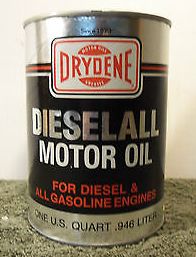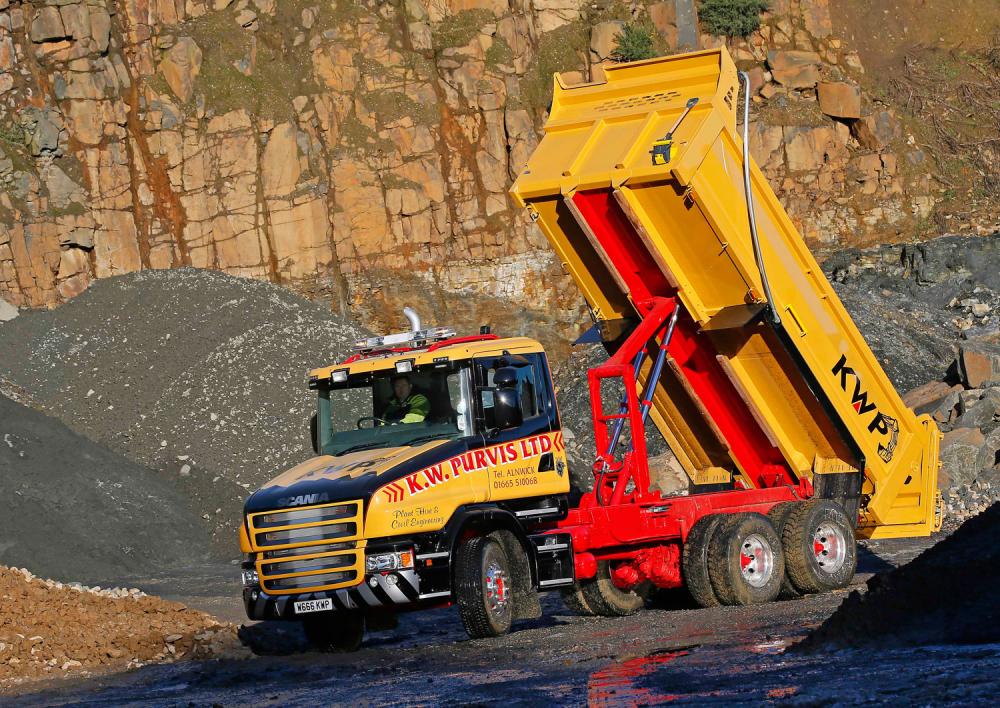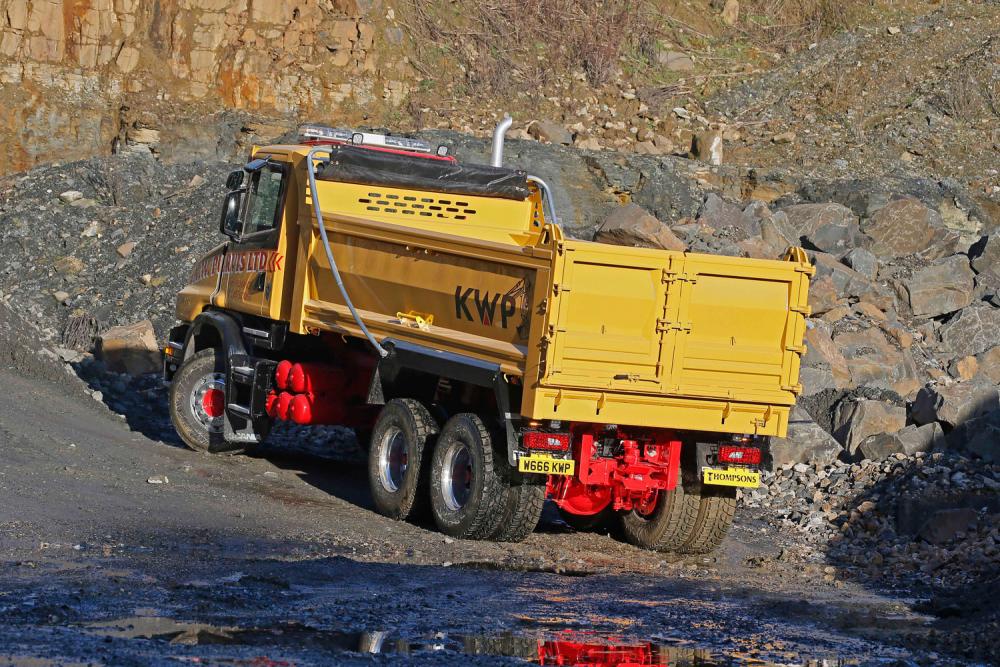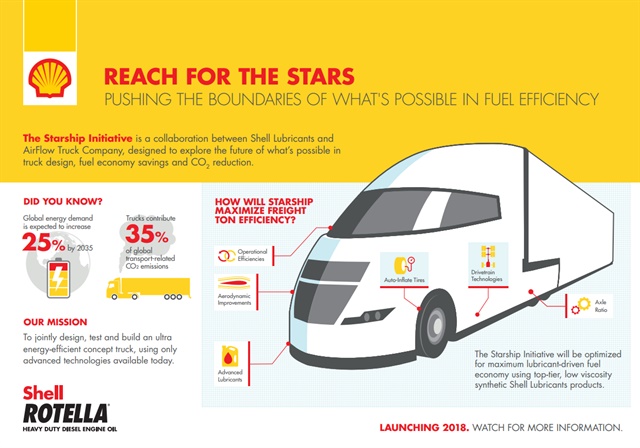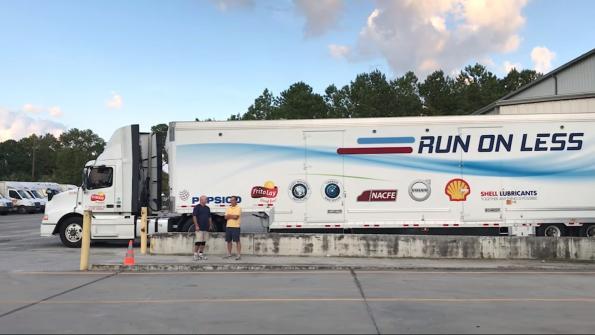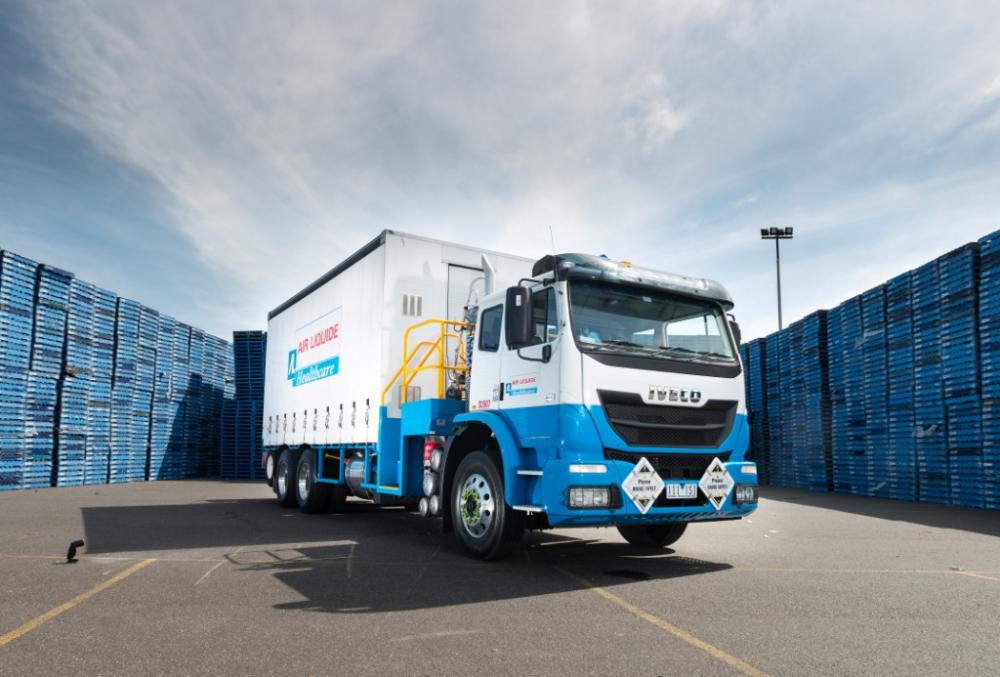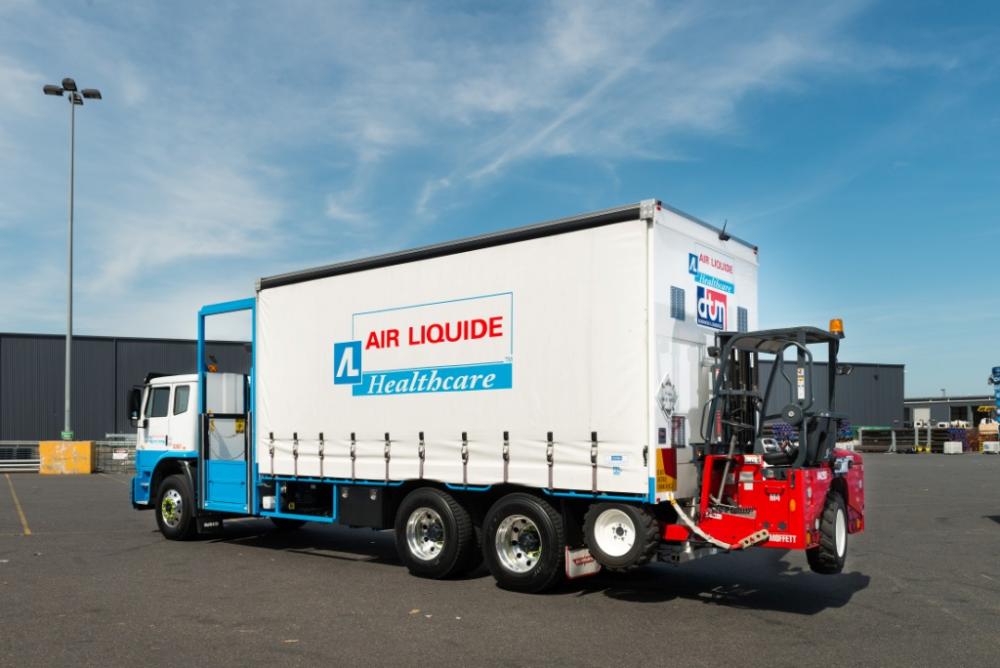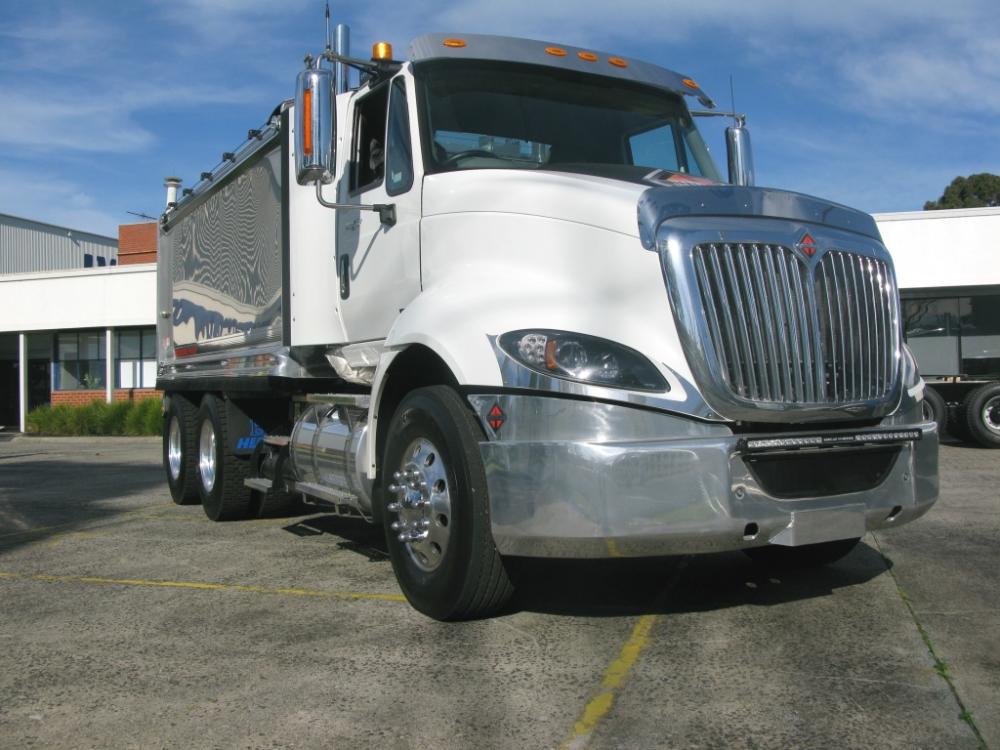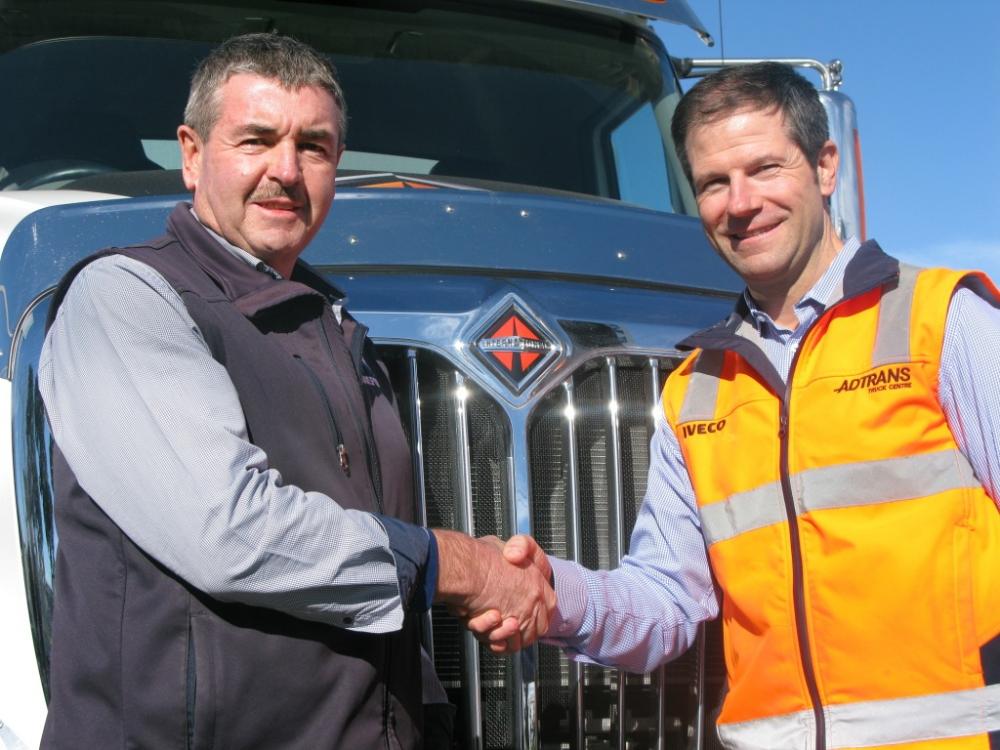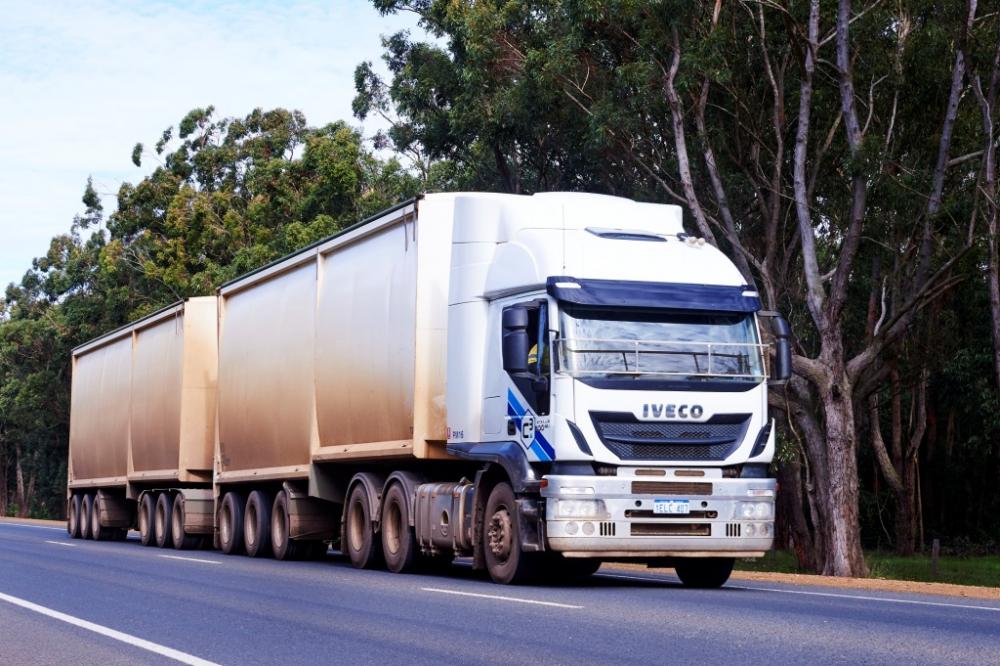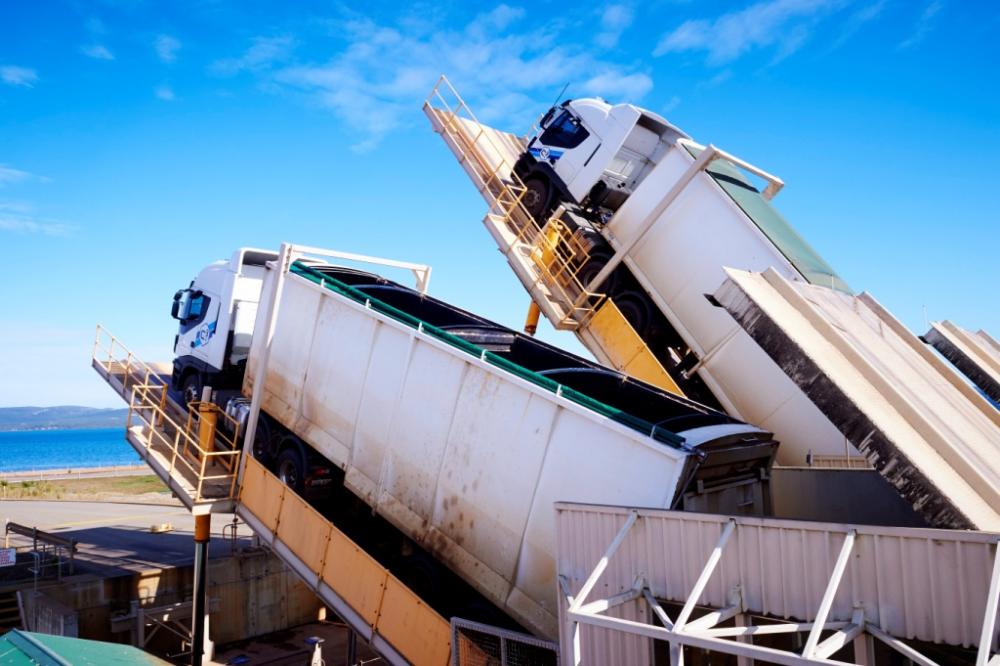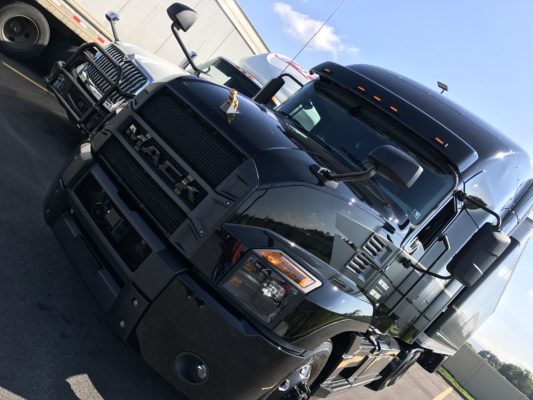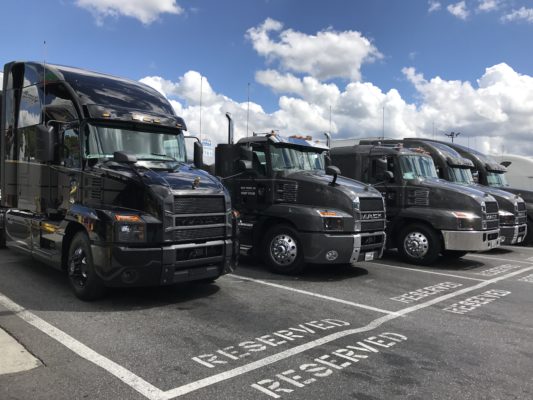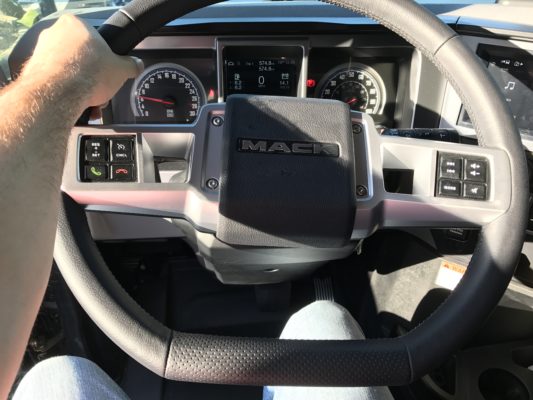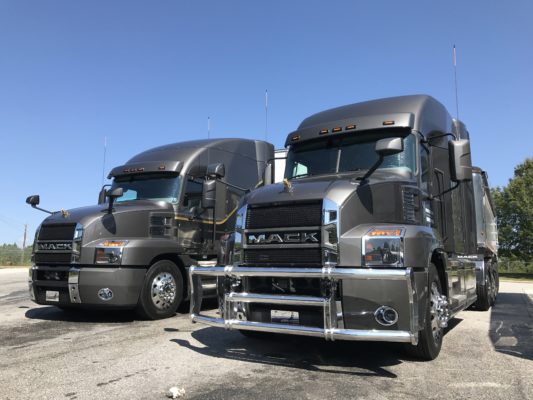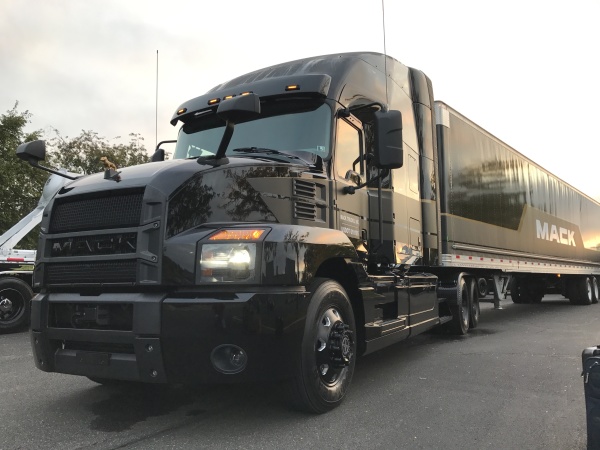
kscarbel2
Moderator-
Posts
18,868 -
Joined
-
Days Won
114
Content Type
Profiles
Forums
Gallery
Events
Blogs
BMT Wiki
Collections
Store
Everything posted by kscarbel2
-
The Mack brand's involvement in manufacturing now only includes Macungie, and that facility has no involvement with this matter. The Renault Kerax 8x8s are sent over in KD (knocked down) form from Renault in France, and assembled at Volvo's Prevost coach plant in Canada.......with a Mack emblem. Mack Defense was set up as a shell company to sell to the US military, as foreign truckmakers have little chance of getting orders. Renault Trucks Defense builds a great truck, but the US and Canada should buy North American trucks. Oshkosh units are every bit as good.
-
Owner-Driver / September 14, 2017 The inaugural Western Star Trucks Show n Shine on September 9 brought out the best representatives of the North American brand in south-east Queensland and beyond. Penske Commercial Vehicles hosted its first ever Western Star Trucks’ Show n Shine on September 9 at the Mt Cotton Training Centre near Brisbane. The event coincided with celebrations centring around the 50th anniversary of the Western Star Trucks brand. As well as trucks, the Show n Shine also featured a range of fun family activities including appearances by Shell V-Power Racing drivers Fabian Coulthard and Scott McLaughlin, a Shell V-Power Racing car and MC Neil Crompton. The trucks on display were judged and over $50,000 worth of prizes was awarded across a range of categories, including KS Easter’s customised 200th truck which took out both the Truck of the Show and the Best Western Star under 5 years awards. Kevin Dennis, managing director of Penske Commercial Vehicles, says it was a fantastic day seeing all the Western Star and White trucks on display and looking their best. "We know how passionate Western Star owners are, so it was a pleasure to host the Show n Shine and have such a great turnout of owners and drivers and their families and friends. "In keeping with Penske’s customers first philosophy, our aim is to meet directly with customers through our events and through our dealers," Dennis says. "Direct customer events, such as Show n Shine, not only allow customers to provide their feedback on the product range and how we can work with them to maximise support, but also provide a great opportunity for fleet operators and owner-drivers to network with each other. "We also had fantastic support from our suppliers and sponsors who helped to make it the great day it was," Dennis adds. As well as the aforementioned awards, K S Easter took home the trophy for Best Western Star Fleet. Other winners included trophies for Corbet’s Group for Best Western Star under 10 years (5-10 years) with its 4900 model, North Qld Truck & Machinery Movements’s ‘PhatCat’ 4800FXC for Best Western Star over 10 years, and Vince Humphreys Transport’s Best Tipper award for its 4800 model. TRN Haulage took home the award for Best Heritage White Truck with itsWhite Road Commander. Dennis says Penske Commercial Vehicles is already working to make the 2018 Show n Shine even better. Photo gallery - https://www.ownerdriver.com.au/events-news/1709/western-stars-shine-at-mt-cotton
-
National Post / September 24, 2017 Last year the Canadian International Trade Tribunal ruled that the process, which awarded the truck contact to Mack Defense of the U.S., was flawed The Canadian government has gone to court to overturn a trade tribunal ruling that it bungled the $830-million purchase of new trucks for the military. Last year the Canadian International Trade Tribunal (CITT) ruled that the process, which awarded the truck contact to Mack Defense of the U.S., was flawed. The CITT found in favor of Mack’s rival, Oshkosh, and called on Public Services and Procurement Canada to conduct a new evaluation of the trucks to be bought for the Canadian Forces. The ruling was yet another blow to the program, which had been trying new trucks since 2006. But instead of complying, the federal government has decided to challenge the CITT decision. Public Services and Procurement Canada declined comment as the matter is before the Federal Court of Appeal. “The contracts with Mack Defense LLC have not been cancelled and the project is moving forward as planned,” department spokesman Nicolas Boucher stated in an email. Department of National Defence spokeswoman Jessica Lamirande said the first delivery of the trucks is expected sometime in late fall. The final delivery is expected in mid-2019, she added. The Conservative government announced in 2015 that [shell company] Mack Defense had won the $834-million contract to provide 1,500 trucks [re-badged Renault Kerax 8x8 trucks]. Oshkosh then challenged the award before the CITT, arguing that there were significant errors in the evaluation of the vehicles. The CITT, which reports to Parliament, provides Canadian and international firms with a process to investigate complaints against federal government procurement. At the time of the CITT ruling, Oshkosh issued a statement that while it was “disappointed in the significant errors found in the conduct of the evaluation process, we look forward to a fair and timely implementation of the Tribunal’s recommendations.” The company has declined to comment on the federal government’s appeal of the CITT findings. But industry representatives point out that if the federal government loses its court case, it will likely have to pay significant penalties to Oshkosh since the trucks being provided by Mack will have already been delivered. Mack Defense, of Allentown, Pa., has been awarded two contracts to provide standard military pattern trucks and related equipment for the Canadian Forces. Assembly will take place in a Sainte-Claire, Que., plant operated by [Volvo Group bus subsidiary] Prevost, one of the firms partnered with Mack. The project to replace 1980s-era military transport trucks was originally announced in 2006 by then Conservative defence minister Gordon O’Connor. It was considered a priority because the vehicles they were to replace had become a safety hazard, with faulty brakes and excessive rust. But the truck program has been plagued by problems and missteps by the DND. At one point the Conservative government stopped the procurement process entirely after DND tried to spend hundreds of millions of dollars without permission. The department had received government approval to move forward with a $430-million purchase of 1,500 trucks. But in subsequent years, department and military officials began adding more capabilities to what they wanted in the vehicles, bumping the estimated cost to more than $800 million. And in an unprecedented move, DND officials continued on with the acquisition without getting government approval to cover the extra hundreds of millions of dollars. When Treasury Board and Conservative government officials discovered in 2012 what was happening, they intervened, shutting down the project, just minutes before bidding was to close. It was restarted in 2013. In addition, the Ottawa Citizen reported that in 2008 and 2009, infighting between army and DND officials over the requirements for the trucks led to further delays. At the time, the DND issued an email statement: “The project is not in trouble.” Related reading - https://www.bigmacktrucks.com/topic/40960-volvo-group’s-mack-defense-unit-to-supply-1500-re-badged-renault-kerax-8x8-trucks-to-canadian-armed-forces/?tab=comments#comment-296894 http://www.renault-trucks-defense.eu/Defense/KERAX/KERAX-8x8
-
Jay Leno's Garage - 1911 Christie Fire Engine
kscarbel2 replied to kscarbel2's topic in Odds and Ends
Related viewing: . -
Shell touts progress with new oils, expands Rotella line
kscarbel2 replied to kscarbel2's topic in Trucking News
Drydene Oil, founded in 1893 in Baltimore, sold out to foreign aggressor Castrol (UK) in 1991. This is a pre-Castrol can of Dieselall. -
Scania launches next generation “XT” construction range
kscarbel2 replied to kscarbel2's topic in Trucking News
In viewing this video, on the history of Scania in the construction industry, you'll note that at once time (many years ago....when BC Mack was a young man), most Scania trucks were "conventionals" (trucks with a hood/bonnet). But in pursuit of more efficient transport, Scania transitioned to cab-over-engine design. The last Scania conventional was the "T Series", utilizing the COE cab. It's still available via special order through a third party. . . Alnwick, Northumberland, UK-based K.W. Purvis. (Thompson "Loadmaster" double-wall body) -
Scania launches next generation “XT” construction range
kscarbel2 replied to kscarbel2's topic in Trucking News
Lifetime costs mean everything Scania Group Press Release / September 18, 2017 Paul Smart Transport is operating at the forefront of the fast-changing construction industry. That’s why the UK haulage contractor has been testing Scania’s new construction vehicles for more than a year. Fierce competition and changing legislation have made Paul Smart Transport an innovative and demanding haulier. The company is based in Bristol, in the UK, and operates a fleet of 35 trucks. “In 2008, 100 percent of our fleet was from another truck brand,” says owner Paul Smart. “Today, we are 100 percent Scania. “We get a very low vehicle downtime” “This change is due to the total operating economy,” he explains. “For sure, the upfront cost of a Scania vehicle may not be the cheapest, but with its reliability, fuel economy and the support we get from the dealerships, we get a very low vehicle downtime. “And together with the services we get, this is the most cost-efficient solution for a construction haulier today,” he says. Paul Smart has the ‘2+2’ on all new Scania trucks, which means a two-year warranty and two years service, including the yearly Ministry of Transport test. This, he says, gives him peace of mind and enables him to plan all maintenance ahead at a fixed cost. “In the past few years we have constantly checked and compared Scania with other brands, but we have stayed with Scania because no one beats their lifetime cost,” he says. Smart started his own company in 1993, and since beginning with just one second-hand truck Paul Smart Transport has become a sizeable and innovative modern construction haulier. Today the company delivers asphalt, aggregates, sand, animal feed, glass and agricultural crops all over the UK. “Improving efficiency is more important than ever” “With constantly shrinking margins in the construction transport industry, improving efficiency is more important than ever for operators like us,” Smart says. “We need really reliable vehicles. That’s why we only work with Scania.” Over the years Paul Smart has seen many changes in the construction transport business – and he has constantly adapted his company’s strategies and vehicle fleet in response. “The most important changes have been the much longer distances and heavier loads in our business,” Smart explains. “Like most contractors, we used to work locally. Now we often deliver heavy loads of gravel or asphalt for road construction work that is more than 100 kilometres from Bristol. And that of course puts new demands on the vehicles we need. They must be robust and fit enough for tough operations in gravel pits and on dirt roads. At the same time they need to be fast and adaptable to the traffic on our highways.” When asked to participate in Scania’s field tests of the new construction vehicles, Paul Smart immediately came up with some ideas to reduce the weight of the vehicles, to allow for a higher payload. “Weight is crucial for us, especially in these longer transport missions,” says Smart. “If we are to earn some money in this business we need to load as much as possible as efficiently as possible, under the existing legislation.” Smart adds that reliability of the vehicles is also of the utmost importance. “We are delivering products to customers working with highway maintenance. That means there are people there who are waiting for us and who are completely dependent on our deliveries.” If the vehicle doesn’t get there in time, there will be penalties and charges. “But never for us,” says Smart, proudly. “The uptime we find with this new Scania is absolutely brilliant. Downtime doesn’t exist. The support we get from the local dealerships to keep us moving is outstanding.” The construction industry in south-west England is booming, and demand for road surface material is higher than ever. “So we need to increase our capacity and be more efficient,” says Smart. “Then we need lighter vehicles that can take heavier loads.” The field-test tipper that Paul Smart Transport is using in its operations is an eight-wheeler Scania G 370. Jason Townsend is extremely proud that he was chosen as a field-test driver for this future construction vehicle. Five days a week he transports gravel from a basalt quarry to an asphalt plant at Avonmouth, near Bristol. From there he delivers hot asphalt to road-building sites in the region. “The road surface varies a lot” Townsend explains that operations can vary from one day to another. “Some days it’s just short transports, with lots of starts and stops,” he says. “Other days it’s long distances with just a few stops and drops. The road surface varies a lot too. It can be very rough roads at low speed in the morning and hard surfaces at high speed in the afternoon.” Townsend comes from a haulage family and grew up around trucks. He sees his mission as a once-in-a-lifetime experience and he only has praise for the new truck. “From where the product was before,” he says, measuring with his hand above his head, “it has now gone up through the roof! That goes for the steering, the gearshifting, the braking system, the vision from the cab – everything relating to safety has been vastly improved. “The thing I like most is the improved braking system,” he says, “especially in combination with the retarder. As a driver you really feel you are in full control with this vehicle.” . -
Scania Group Press Release / September 23, 2017 With 2.7 million cars, 210,000 trucks and 208,000 buses and coaches registered in the Greater London area, providing deliveries to construction sites in the British capital is a daily challenge. Quattro’s fleet of mixer trucks service building sites all over the city from its two batching plants in West London. Mastering London traffic is an art fine-tuned through experience and Quattro has loads of experience. The mixer trucks have a time window of just two hours from mixing water to the cement and aggregates at the depot to discharging concrete at sites. A single road accident can cause serious disruption and although this may render the concrete unusable for the customer, additives can retard the stiffening process in the drum. Streamlined filling process At its West London batching plant in Park Royal, Quattro has a streamlined process for filling up mixer trucks as quickly as possible. Before they are allowed back in traffic, they must be thoroughly hosed down to avoid loose gravel from soiling public roads. “Approximately 75 percent of our fleet is Scania,” says General Manager Robert Duddy. “In this industry, it is all about availability of the vehicles, they need to be available 100 percent of the time. For that reason, we choose Scania.” Quattro carries out most maintenance and repairs in-house as well as making use of Scania workshops. “Having our in-house facilities, we are able to carry out work during nights to make sure that the trucks are available the following morning.” There is no lack of demand for Quattro’s products in London. Europe’s largest construction project, Crossrail, is nearing completion while around 70 high-rise buildings are under construction with another 200 more planned. High volume, low margin “However, this is a very competitive high volume, low margin, industry. It’s difficult to increase volumes so it’s all about service. Again, this means that the availability of the trucks and having an efficient fleet is very important.” Ultimately, London is London and the biggest daily obstacle is traffic, Duddy notes. “London is a large city, it’s a busy city and there is always something that could happen. We have satellite tracking on all our vehicles and can, if need be, re-route them.” However, traffic is not the only jeopardy. “We work in an industry where things do go wrong. We can have four-five trucks waiting on a site because they’ve had a breakdown and are unable to use the material.” Driving construction vehicles in London is another challenge. London has recently announced a five-star safety rating system whereby trucks with the lowest rating will be banned from city roads. Quattro’s trucks are therefore CLOCS, Construction Logistics and Community Safety, compliant and equipped not only with close-proximity mirrors but also with side-view cameras. “The biggest improvement in our truck would be driver’s visibility,” says Duddy. “We operate in a congested environment with vulnerable road users. The driver therefore needs as much visibility as possible but also comfort to be relaxed and in the best frame of mind to drive.” .
-
Scania Group Press Release / September 12, 2017 By carefully monitoring levels of vehicle-use and adjusting service intervals to match, Scania’s Maintenance Flexible plans ensure every truck receives exactly the right level of care. .
-
Rubber Tire Loaders - The Trend Towards Hydrostatic Drives
kscarbel2 posted a topic in Odds and Ends
ForConstructionPros / September 22, 2017 Doosan loader specialist Mike Stark talks about the some key advantages of hydrostatic wheel loaders and the applications where they shine. . -
U.S. Businesses Can Expense Up to $500K in Truck Purchases
kscarbel2 posted a topic in Trucking News
Heavy Duty Trucking (HDT) / September 22, 2017 The U.S. Internal Revenue Code, Section 179 (commonly referred to as IRC-179) allows businesses to expense up to $500,000 in the tax year 2017 for certain capital expenditures, including commercial work trucks. Normally, capital expenditures must be handled as depreciable assets. However, provisions of IRC-179 allow a taxpayer to elect to treat the cost of qualifying Section 179 property as an expense in the tax year in which the equipment is placed in service, rather than as a depreciable asset charged to a capital account. For qualifying equipment placed in service in a business’s tax year beginning in 2017, the limit is $500,000. Specific provisions and restrictions do apply, and every business’s tax situation is unique, so business owners should consult their own tax accountants or attorneys to determine how much tax saving, if any, IRC-179 could provide. -
Shell sponsoring new “hyper-fuel mileage” tractor-trailer design
kscarbel2 replied to kscarbel2's topic in Trucking News
Shell’s Starship Truck Focuses on Freight Efficiency First Heavy Duty Trucking (HDT) / September 22, 2017 Shell Rotella’s next-generation concept truck, nicknamed the Starship, is set to debut early in 2018 and the company says it will focus on freight efficiency rather than raw miles per gallon. The truck, which the company has been teasing since 2015, is a collaborative effort between Shell and the Airflow Truck Company, which builds custom Class 8 trucks and trailers designed to push aerodynamic, fuel-efficient design. For this project, the cab of the truck and the trailer are being custom made to reduce weight and rolling resistance while streamlining aerodynamics. While not designed to be put into production, the concept vehicle is also not supposed to represent a far-flung future. Bob Mainwaring, Shell Lubricants technology manager for innovation, explained to reporters at a California briefing this week that it is Shell’s vision for 5-15 years in the future. A lot of emphasis was placed on freight ton efficiency as the primary metric for the Starship vehicle, eschewing fuel economy as the be-all and end-all of fuel efficiency. Mainwaring described freight ton efficiency as maximizing the usefulness of fuel mileage. When tuning a vehicle for fuel economy, the best way to achieve it is to run lightweight and slow, he said. However, using gallons per ton-mile instead of miles per gallon incentivizes carrying as much weight as possible as efficiently as possible. “Go Slow, Go Heavy” is the mantra for thinking about how to improve freight efficiency. An example Shell gave was that a car with one passenger might achieve 30 mpg and be considered fuel efficient. But that same car carrying three people and only hitting 28 mpg is actually being far more efficient overall. In other words, the more goods you carry, the more efficient your fuel usage actually is. To improve freight efficiency, the Starship project has emphasized aerodynamics, lightweighting, reducing rolling resistance, and use of low-viscosity oils. When the Starship is finally unveiled next year, Shell plans to take the vehicle coast to coast to test it, from California to Florida on a drive designed to maximize efficiency and generally avoiding congestion when possible. The company says it isn’t aiming for specific number goals and is treating the Starship as “thought leadership on wheels.” . -
Run on Less Kicks Off as Participants Aim for 9 mpg
kscarbel2 replied to kscarbel2's topic in Trucking News
Driver Sustains Over 11 MPG for 5,600 Miles Heavy Duty Trucking (HDT) / September 22, 2017 Driver David Gooch was able to sustain 11.21 miles per gallon over 5,599 miles during the #Raceto10mpg challenge put on by Cumberland International and Sharp Transport. To achieve the high mileage figure, Gooch made extensive use of cruise control in order to stay in top gear as often as possible. He managed to keep cruise control on 83% of the time, allowing the truck to stay in top gear 89% of the time. During the time the vehicle was in top gear, it averaged 12.34 mpg. Gooch stayed in communication with personnel at Sharp Transport throughout his run for day-to-day telematics reports. These reports helped him tweak his driving habits and routines to maximize his overall fuel economy during the nearly 6,000-mile run which took him through 10 states. Gooch was one of two Sharp Transport drivers given Cumberland International’s C10 LT demo truck. The C10 is a truck spec’ed by the Tennessee dealership with the best fuel-saving options it has to offer. Cumberland allows fleets to try out C10 trucks for free to see how the spec works in their operations. . -
Run on Less Kicks Off as Participants Aim for 9 mpg
kscarbel2 replied to kscarbel2's topic in Trucking News
Run on Less: We're averaging 10.1 mpg in Class 8 trucks Aaron March, Fleet Owner / September 22, 2017 With fuel-saving technologies, trucks capable of even more — but real-world conditions take their toll Midway through their cross-country exhibition run converging on Atlanta this weekend, the Run on Less truck efficiency roadshow vehicles are seeing some impressive double-digit mpg results. But real-world conditions have factored in, demonstrating the challenges fleets face in getting optimal fuel efficiency from their trucks. Run on Less is sponsored by Shell and PepsiCo and hosted by the North American Council for Freight Efficiency (NACFE) and Carbon War Room (CWR). Seven fleets committed trucks to participate in the roadshow, including Albert Transport, PepsiCo's Frito-Lay division, Hirschbach, Mesilla Valley Transportation, Nussbaum Transportation, Ploger Transportation and U.S. Xpress. "This is real drivers on real routes hauling real freight," said Mike Roeth, executive director of NACFE and operations lead for Trucking Efficiency, a joint NACFE-CWR effort that studies and reports on various heavy truck fuel efficiency technologies. The Run on Less trucks are on their normal routes and are equipped with Geotab telematics devices to stream data to the team monitoring results like vehicle speed, elevation, gallons of diesel burned and miles traveled. "It's consistent across all seven trucks, and we're using that to populate RunOnLess.com. These are not test vehicles that have been designed specially for fuel [economy]; these are not on special tracks or anything like that," Roeth noted. Early results The roadshow is holding a press conference this Sunday at the North American Commercial Vehicle Show to provide results and observations from the trucks in more detail. Before then, however, Roeth said the Run on Less trucks so far have averaged 10.1 mpg, nearly 4 mpg higher than the 6.4 mpg average of all Class 8 trucks operating across the U.S. and Canada. Over the 31,000 collective miles they'd traveled, that means the Run on Less trucks saved some 1,800 gal. of diesel fuel and about $4,500 compared with that Class 8 average. If all those 1.7 million U.S. and Canadian trucks were as efficient as the seven in the Run on Less roadshow, "we would save 9.7 billion gal. of diesel fuel, $24 billion and 98 million tons of CO2" every year, Roeth pointed out. Challenges Among the Run on Less trucks, the highest daily fuel efficiency observed at this point was 12.8 mpg and the lowest was 7.4 mpg. The differences were driven by factors like the weight of the payload in the trailer, wind direction and speed, elevation and speed at which the trucks were driven. "The last few weeks have been really challenging for moving freight around our country," Roeth noted. "With Hurricanes Harvey in the Gulf and in Texas and Irma in the Caribbean and Florida, our dependency on oil in this country has become obvious." The hurricanes affected the Run on Less trucks, he added, with some having to alter routes, encountering problems getting fuel and experiencing high winds that affected their fuel efficiency. On that latter point, wind can be a benefit if it's coming from behind, but any other direction is a detractor. Meanwhile, Frito Lay's snack manufacturing operations in Georgia and Florida were disrupted for many days, "challenging that particular Run on Less truck to catch up," Roeth said. Another observation the Run on Less exhibition has noted is that the trucking industry's common "drop-and-hook" operations can have a big effect on fuel economy. A driver takes a load to its destination, drops it off and takes on another load, and the trailer that's picked up might not have the same aerodynamic and other fuel-saving technologies. Drivers in the Run on Less lineup pointed that out. They cited trailer tails as a big loss if they switched from a trailer with one to another without; handling also isn't as good in that case, with more wind drag forming in that boxed-off, standard end of a trailer. One driver said the lack of a good trailer tail could shave off half a mpg in fuel effiency. Trailer wheel aerodynamic fairings and dual wheels vs. "super single" wide-base tires are a few more efficiency technologies that drivers may find themselves suddenly with or without. "From a fuel efficiency standpoint, the difference between the same tractor hauling a highly efficient trailer — one with these technologies we've talked about vs. one that doesn't — can be 10% to 15%," Roeth said. That can make a big difference for fleets. With just that 10-15% difference, hauling a less-efficient trailer can add up to about $4,000 per year for a single truck. What's more, older trailers may also be poorly maintained. "Maybe it has poor alignment, poor tire pressure or other things that could negatively affect fuel economy," Roeth noted. Thus even fleets equipping their trucks with the latest fuel-efficiency technologies may find reaching that optimal mpg in the real world elusive. . -
Automotive News / September 22, 2017 WASHINGTON -- Consumers Union is lobbying Congress to require public disclosure of fuel economy estimates for heavy-duty pickups so buyers can make more informed choices, after its tests found diesel-powered trucks underperformed gasoline-powered trucks. Automakers are required to post window stickers on new light-duty vehicles showing estimated fuel economy, but there is no such mandate for trucks with gross vehicle weights exceeding 8,500 pounds. The latest issue of the public interest group's magazine, Consumer Reports, includes a report about tests it conducted on four popular heavy-duty pickups: the Chevrolet Silverado 2500 HD, Ford F-250, Ram 2500 and Nissan Titan XD. The tests found that the greater efficiency of their diesel engines does not make up for the extra weight they carry. The heavy-duty trucks achieved 14 to 15 mpg, or about 1 to 2 mpg less than their gasoline-powered light-duty counterparts. Different tests But it is challenging to evaluate the claims in a comparative way because Consumer Reports' test protocols differ from those of the EPA, including types of gasoline and driving methods. Plus, there are no government fuel-economy standards for heavy-duty pickups to meet as there are for light vehicles. Most diesel-powered heavy-duty trucks are sold to consumers who use them for towing and hauling heavy loads. Under those conditions, diesel engines are generally more fuel efficient than gasoline-powered trucks. The EPA enforces emissions standards for heavy-duty pickups, but compensates for the difference in usage from passenger vehicles by including a work factor for the payload. And the work factor varies for each model. Letter to leaders Consumers Union sent a letter to Senate and House committee leaders on Sept. 20 requesting that they authorize and appropriate funds to the National Highway Traffic Safety Administration and the EPA to make information on fuel economy, emissions and the expected average fuel costs available to the public. "Based on new data from testing at Consumer Reports, these heavy-duty diesel pickups cost about $35,000 to fuel over the first 15 years of the vehicles' lives. Further, they can cost $7,000 to $10,000 more to fuel than their light-duty gasoline counterparts over that same time," said David Friedman, director of cars and product policy and analysis at Consumers Union. "Without information like this, consumers are powerless to make informed decisions when shopping for these vehicles for their businesses or family." Friedman, who resigned as NHTSA's deputy administrator in July 2015 after two years at the agency, said the EPA has the raw fuel economy data on heavy-duty pickups in the form of gallons per ton mile -- one ton of cargo transported one mile -- as provided to the agency by automakers, so making the data available to the public would require a minimum of extra effort. The group said the fuel economy data should be published on the government website fueleconomy.gov and eventually publicized via a window label on new vehicles. But the EPA's fuel-economy data on heavy-duty trucks is less comprehensive than the more robust tests required of light-duty vehicles. "Everyone knows that the certification tests are pretty gentle and there's a gap between real-world use," Friedman said in an interview. "So, if, and when, they put out certification numbers, they will probably overestimate fuel economy. But we believe consumers are better off with some data than no data." Consumers Union said funding is needed because NHTSA and the EPA lack the resources and staff needed to get the project off the ground. Rules review The group's request comes as the Trump administration considers whether to loosen fuel economy mandates -- known as the corporate average fuel economy rules -- for cars and light-duty trucks in the 2022-25 model years.
-
In my eyes, Western Star's most attractive product is distributed in Australia (and Roger Penske is the national distributor). Note the trailer is a Freighter......Australian engineering impresses! https://www.bigmacktrucks.com/topic/45626-tested-freighter’s-latest-eziliner-curtain-sider/?tab=comments#comment-336298 https://www.bigmacktrucks.com/topic/46381-freighter-launches-new-t-liner-ii-trailer/?tab=comments#comment-341783
-
Shell touts progress with new oils, expands Rotella line
kscarbel2 replied to kscarbel2's topic in Trucking News
Years ago (seems like only yesterday), Lindsay Drydene (Drydene Oil) himself told me, speaking of their 15W40 "Dieselall" product aimed at companies who wanted one product for all their diesel and gasoline machinery/vehicles, that the additives used in a diesel engine-applicable oil are far harsher than those of a gasoline engine-specific oil. Consequently, those extra cleansing additives in 15W40 for the diesel requirement will reduce the life of a gasoline engine. He recommended I use his gasoline engine-purpose intended oils in my cars. -
Iveco Australia / August 30, 2017 It’s common for an ACCO to deliver concrete, remove waste or drop-off equipment on a tilt tray, but the same benefits that make the ACCO a favourite in these applications is proving to be an excellent fit for the delivery of medical gases. The K&S Group is a prime contractor to Air Liquide Healthcare, a leading provider of respiratory care services and medical gases, and recently joining service on the contract was a new model ACCO 6x4 fitted with a unique curtainside body, incorporating rear-mounted Moffett forklift and sidelifter. The ACCO’s low tare weight provides the scope for a high payload while still accommodating the Moffett forklift, leading to a very flexible delivery vehicle. Even with the forklift, the ACCO offers over 10.7 tonnes of payload. The tray accommodates 10 stillages, each stillage houses 15 cylinders of medical gases. In this application, the Moffett is used to unload the larger stock quantities and not disrupt any customer workers at the delivery point – and there’s no need to wait for a forklift. Some of the clients, such as hospitals don’t have their own forklifts which makes the ACCO’s set-up even more practical. As well as delivering from home base in Melbourne to regional cities as far away as Albury, the ACCO is also used on metropolitan routes, where again flexibility is the key. Delivering to hospitals in inner-city Melbourne, the roads and access can be tight, having the Moffett which is road registered allows for the vehicle to be parked in a suitable location, with the delivery being completed into the more restricted areas with the forklift. For efficiency and safety, the ACCO is fitted with an in-cabin camera and data tracking device, other security features include keycode access to the cargo area. Along with delivering via the rear-mounted forklift, the ACCO’s curtainside body features a sidelifter which allows the driver to safely and conveniently unload smaller cylinder quantities – these can weigh as much as 60 kilograms each, so the lift is a necessity. Given the customised nature of the body, IVECO Australia worked closely with the K&S Group and bodybuilder, Fleetweld, to adapt the ACCO cab chassis along the assembly line, allowing for faster and more efficient body fitment. Amongst the special requirements was about a metre of space behind the cabin for the side lifter platform as well as room for steps, this involved relocating battery boxes and fuel tanks, a request comfortably accommodated by IVECO’s engineering and production teams. This ACCO is equipped with an 8.9 litre engine producing 320 horsepower (239kW) and 1350Nm of torque, and when combined with the Allison Gen 5, 6-speed full automatic transmission, provides a comfortable and hassle-free driving experience. Driver feedback has been very positive, with comments made regarding comfort – even after long trips – and clear instrumentation. Vehicle servicing is undertaken by K&S Group’s in-house maintenance division, it’s a straightforward process thanks to excellent parts availability particularly with the ACCO’s American drivetrain. .
-
- 1
-

-
Iveco Australia / August 28, 2017 What does one of Australia’s biggest INTERNATIONAL Truck brand aficionados do when he hears that the highly anticipated ProStar will soon be available in Australia? Treloar Transport Managing Director, John Treloar, wrote to the company expressing a strong interesting in ordering the first of the new breed INTERNATIONALs to be available here. John’s new order is a fitting full circle to INTERNATIONAL’s recent history in Australia, as he remains the proud owner of the last new INTERNATIONAL to be sold in the country, a 9900 Eagle day cab tipper, purchased by him on 20 January, 2011. According to John, the wait will be worth it – INTERNATIONAL Trucks have always served him well in business. As owner of Treloar Transport, a Tassie-based civil contracting business, he has owned around 15 INTERNATIONALs since operating the company. “Early on when we were getting up and running many years ago with my father Cliff and brother Tony, we were using old Bedfords and progressed to MANs, then we wanted something bigger that was also able to tow a trailer,” John said. “One of the local dealer salesmen, Brendan Smith, recommended a second hand 1986 S-Line. We were a bit hesitant because it already had 500,000 clicks on it, but Brendan told me it would do a million guaranteed, so we went for it and it hit 1.1 million without a problem. “At this point it developed a water leak at the head so I bought a rebuild kit to suit the Cummins 350 big cam and it only cost me $1800… Our competitors were running around in other brands and paying big money for rebuilds and maintenance, so I thought ‘this will do me’. “The INTERNATIONALs have always been good, honest and reliable trucks.” As a loyal fan of the brand, John said he was quite worried that the last truck he purchased in early 2011 might mark the end for INTERNATIONAL Trucks in Australia. “I thought that was it, so I went out and bought another two second hand 9900 models to try and keep us going into the future, I thought I’d be able to rebuild these, but for our new trucks we didn’t know where we’d go to next. “Then the first announcement came that INTERNATIONAL might be coming back, which was great news.” The majority of Treloar Transport’s fleet are configured as tipper and super dogs, along with two prime movers for float and semi work. The new ProStar will also work in a tipper and dog application and will have the familiar Cummins / Eaton driveline combination. John said the truck will be put to work in a demanding application but had total confidence that the ProStar would be up to the challenge based on the earlier performance of his other INTERNATIONAL trucks, as well as the bullet-proof specification of the local model. “Where we are south of Devonport the conditions are challenging and the application demanding,” he said. “The terrain is undulating, the trucks operate at a heavy weight, often travelling on gravel roads that are wet and slippery, the weather conditions can also change pretty fast.” “I’m expecting longevity out of the ProStar, especially if it’s anything like the others. We still have a 1982 S-Line on fleet that is running strongly. “I reckon the die-hard INTERNATIONAL guys will definitely pick-up and run with this model,” John added. Fittingly, the new ProStar was purchased through the recently appointed INTERNATIONAL Dealership, Adtrans Truck Centre. The Adtrans Group’s second Victorian INTERNATIONAL® Dealership, Melbourne Truck Centre, is the same outlet where John purchased his last 9900 Eagle. .
-
Iveco Australia / August 25, 2017 The growing trend among many transport and logistics providers is to offer a full suite of services that meet their customers’ need all along the supply chain – this can result in a diverse fleet of vehicles selected on their strengths for the particular application. New Zealand logistics company C3 is a case in point, providing its Kiwi and Australian client base with transportation, warehousing, marshalling and stevedoring services throughout both countries. To assist in the specialised transport of wood chips from sustainably-grown plantations in Southern WA to Albany Port, the company has identified a range of IVECO Stralis models as an excellent fit for the task. C3 has invested in over 20 Stralis trucks over several years, comprising of earlier series AS-Ls and four new AS-L Series II models that have been added in recent months. C3 Operations Manager – Albany, Craig Fildes, said some of the first Stralis prime movers on fleet are now approaching a million kilometres – these are fitted with Cursor 13 engines producing 500 horsepower and the smooth-shifting EuroTronic II 16-speed AMT. “We began using Stralis AS-L prime movers around six years ago – some of these are still being used and now have over 800,000 kilometres showing,” Craig said. “When it came time to grow the fleet in this application, we opted to continue using AS-Ls, purchasing four of the latest Series II models in March. This time we went for the higher engine output and worked with IVECO to select the best GCM – the AS-Ls allow us to work at our desired target of 90 tonnes which helps productivity. “The AS-Ls do quite an amazing job – they are a good all-round fit for the application. They’re comfortable, quiet, they’re easy to work with and are competitively priced. “A lot of the roads the trucks travel on especially in the plantations – as you could imagine – are not very nice, the trucks can take a battering but the IVECOs handle it well. The drivers are also happy with them, especially with their comfortable, quiet cabin.” The latest AS-L Series II prime movers feature a 560 horsepower, 13 litre Cursor engine coupled to a ZF Eurotronic II 16-speed transmission. For peace of mind, the engine is covered by a market-leading standard warranty of five years or 1,000,000 kilometres. The Stralis prime movers operate five days per week averaging over 400 kilometres per day – the majority of the plantations which they service are located within a 130 kilometre radius of Albany. Along with the WA-based fleet, C3 also operate several trucks from the city of Portland in south-western Victoria in the same application but configured as B-Doubles. Craig said the IVECO models compared well to the higher-profiled European brands. “When you do the numbers on a fleet of trucks the IVECOs make sense because they do a good job and we have less capital tied up in our fleet,” Craig said. “We also have a local company that we resell some of our trucks to – they have a broad range of brands on their fleet and the IVECO models rank highly with their drivers, especially in terms of comfort levels.” With C3 enjoying steady grown and now offering services at 15 ports across Australasia, its partnership with IVECO will likely remain strong, according to Craig. “We do put new purchases out to tender to remain in touch with the market but so far we’ve been pleased with what IVECO has done for us,” he said. .
-
- 1
-

-
Freightliner Trucks / September 21, 2017 . . . . . . . . . . . .
-
Volvo introduces new Mack “Anthem” on-highway tractor
kscarbel2 replied to kscarbel2's topic in Trucking News
Volvo canceled the original YouTube "live reveal" video and re-edited it (Note the now blank video in my 4th post). Here is the new one. . -
Volvo introduces new Mack “Anthem” on-highway tractor
kscarbel2 replied to kscarbel2's topic in Trucking News
Driving the new Mack Anthem James Menzies, Truck News / September 20, 2017 DULUTH, Ga. – The Black Dog led a convoy of 10 Mack trucks on an 850-mile journey through seven states after the launch of the new Mack Anthem highway tractor in mid-September. After a glitzy launch event in Allentown, Pa., Sept. 13-14, the trucks had to make their way to the North American Commercial Vehicle (NACV) show in Atlanta, Ga., where they’ll make their public debut. CDL-holding editors were allowed to participate in the convoy, driving a number of Mack Anthems of various configurations, as well as a Granite and Pinnacle sporting the new interiors. This was a unique opportunity, and one that I enjoyed from start to finish. We had a lot of fun along the way, but the real treat was getting some meaningful time behind the wheel of the all-new Mack Anthem. The Anthem looks like nothing else on the highway, and its bold design commanded a lot of attention along our route. Every time we pulled into a truck stop, the trucks attracted a crowd – especially the Black Dog, an all-black Anthem with decked out interior that was in my mind the star of the show and deserving of the lead position. Drivers climbed around and inside the trucks when we were parked, and during a “truck stop takeover” at the Love’s travel plaza in Raphine, Va., Mack reps handed out free t-shirts and hats. There are undoubtedly more Mack Trucks fans today than when we started our trip. The high interest in the new-look truck was obvious, among truck drivers and even the motoring public. We turned our share of heads on the highway, and that’s a pretty good feeling when cruising down the road in a rig that truckers and even four-wheelers deem worthy of a thumbs-up. The Anthem seems poised for success because it boasts a throwback design, while also improving fuel economy by up to 3% compared to the Mack Pinnacle with sleeper cab. Who says efficiency and bold traditional styling can’t co-exist? From the oversized, boxy headlights, to the squared fenders and robust grille, this is a trucker’s truck. And it’s been built around a Mack powertrain that performs beautifully; the mDrive automated transmission and the MP-series engines have been dialed in to work in harmony. The mDrive shifts precisely when needed and the MP8 provides ample power to pull some significant grades at typical gross vehicle weights. The engine brake was quiet, yet effective, able to hold the truck back even down the long, intimidating Fancy Gap grade averaging 4.5% over six miles. I only tapped the brakes twice on the descent and never felt out of control. Here’s something you won’t see: a Mack with mDrive using one of those runaway truck lanes. I spent most of my time driving two Mack Anthems with 70-inch sleepers, powered by MP8 engines spec’d with 505 hp and 1,860 lb.-ft. of torque. Both had the 12-speed mDrive overdrive automated transmission – a great combination capable of handling most on-highway applications, payloads, and routes you’ll encounter. Both Anthems I drove were also equipped with Bendix Wingman Fusion, and I spent most of my driving time using the adaptive cruise control. This adjusted the truck’s speed to account for nearby traffic, maintaining a safe following distance but only intervening with engine and foundation brake applications when absolutely necessary. Some of the brake inputs were a little harsh, but it did the job. I was impressed that when the truck was okay to resume its cruise speed, it did so in an controlled, efficient manner, and didn’t charge back up to the set cruise speed with a complete disregard for fuel economy. It was a nice way to drive. I appreciated the mDrive when we were in stop-and-go traffic due to construction; a tap of the throttle will prompt the truck to putter along at a slow, steady speed. The 13-liter Mack MP8 was sufficiently powered to pass other trucks on uphill climbs and we were loaded to more than 60,000 lbs. At no time did I feel more power was needed. I did use the kickdown feature a few times for an extra boost of horsepower, which was handy when completing a pass. Drivers who were drawn to the truck by its new exterior, were equally amazed when they poked their heads inside, and for good reason. The interior has also been completely revamped. The steering wheel has a racecar-inspired flat bottom. This is a unique attribute that’s also functional, as it provides a little extra belly room and makes it easier to climb inside the truck or into the sleeper. I like the look of the flat bottom steering wheel and it didn’t interfere with my preferred hand positions at any time or while backing. The steering wheel has been kept relatively simple, with minimal buttons placed on it. The cruise control and radio can be adjusted on the steering wheel, but it’s not overwhelming. The gauges have been repositioned and are much more stylish. The rocker switch icons are etched in to prevent fading, and the entire dash lights up beautifully after dark. All interior and exterior lighting is LED, which provides better illumination while drawing less power. Mack has modernized the instrument cluster while maintaining a truck look and feel. It’s not as car-like as other recently introduced interiors, and I suspect that’ll appeal to many truck drivers. But touch points have been enhanced and the dash and instrument panel are of better quality than those previously found in the Pinnacle. The new interior has been given to the Mack Granite and Mack Pinnacle axle-forward models as well. The Anthem replaced the Pinnacle axle-back model, and will be its top seller, but the axle-forward Pinnacle will be retained and rechristened, simply, the Pinnacle. Pinnacle and Granite customers will appreciate the new interior, which completely revitalizes those models. I spent one leg of the trip driving the Granite, and the new interior makes this workhorse a nicer truck to drive. I can also attest to the quality of the new sound system – who can resist a little AC/DC while cruising down the open road? Mack loaded the Anthem interior with storage. They claim to offer an industry-leading 27 cubic feet, and I wouldn’t dispute their calculation based on an exploratory inspection of the sleeper. They put storage bins and compartments everywhere possible. The redesigned seats are comfortable and easy to position. The door must be closed by the handle, which struck me as odd, but it felt durable. The sightlines are much improved, thanks to a hood that slopes down, and both one- and two-piece windshields are available. The hood-mounted mirrors are perched atop the hood, which makes them look like space alien antennae, but this was done for a reason. They’re aligned with the side mirrors to improve airflow, and they do provide exceptional visibility alongside the truck and trailer. I spent one leg of the trip sprawled out in the sleeper. It takes little effort to get comfy back there and I suspect the Anthem would make an excellent team truck. The sleeper curtain is now attached by magnet rather than Velcro, so a driver who needs to access the bunk while his or her partner is sleeping can do so quietly without tearing back a Velcro curtain. The new stand-up sleeper provides plenty of head room and the radio and temperature controls are well placed for easy access while lying down. The Anthem can be spec’d with single or double bunks. Numerous sleeper configurations are available. Day one of our road trip saw us travel from Allentown, Pa., to Greensboro, N.C. It took about 12.5 hours with stops and gave me a real appreciation for what professional drivers do on a daily basis. Next morning, we were right back at it for the 300-mile run down to Nextran Truck Centers in Duluth, Ga., where the trucks would be put on display for a few days, staged, and then transported to the NACV show in downtown Atlanta. It was exhilarating to pull into the Nextran parking lot, all 10 trucks in formation, air horns blasting, as dealer reps shot video and took photos. The new Mack Anthem is a sharp looking truck, loaded with storage, with a more modern, higher-end interior. The powertrain is dialed in and a pleasure to operate. The truck’s also efficient. What could make it better? Maybe a Canadian edition with our flag displayed on the Anthem badge, and a Maple Leaf tastefully stitched somewhere inside the cab. After all, national pride isn’t just an American thing; a Canadian Anthem would be a beautiful thing. . -
Volkswagen launches all-new Delivery light truck range
kscarbel2 replied to kscarbel2's topic in Trucking News
The 6x2 has been extremely popular with the beverage industry, where, as in the US, they begin the day essentially overloaded. https://www.man-la.com/produtos-volkswagen/modelo/delivery-8/13-160-121
BigMackTrucks.com
BigMackTrucks.com is a support forum for antique, classic and modern Mack Trucks! The forum is owned and maintained by Watt's Truck Center, Inc. an independent, full service Mack dealer. The forums are not affiliated with Mack Trucks, Inc.
Our Vendors and Advertisers
Thank you for your support!


